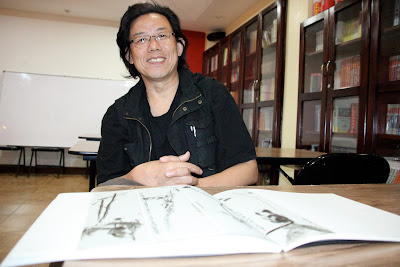Zen and the colours of life in monochrome
 |
| Professor Du Juemin |
“It is a feeling that flows from deep inside,” says Professor Du Juemin, classical Chinese painter, calligrapher and a poet, as he held his hands out as if to absorb energy fields floating in the air.
The spiritual energies guide Du Juemin, an exponent of the minimalist and the simplistic traditional Chinese painting, to capture life’s story in monochrome.
Speaking in Mandarin, his thoughts were translated by Ying Ping Liang, lecturer of Chinese at Confucius Institute, University of the West Indies, Mona.
“The use of monochrome is from the Buddhist ideology of minimalism and the fact that all colours evolve from black and white,” explained Du Juemin, who is visiting Jamaica as artist in residence at Confucius Institute.
The neutrality in his works, he said, is a very noble style of painting and a formidable medium of expression.
Du Juemin’s paintings are a confluence of visual and written thought process – a symphony of poetry with delicate brush strokes. He says that his paintings carry a message and strive to provoke a thought process among the patrons.
The signature stamps have meanings, and as a Chinese practitioner of art, Juemin is both exponent of painting and calligraphy. “It is important not only to know how to paint but also to know calligraphy.”
In one of his paintings, a bird is perched on a tree watching the wind blow away the petals of the flowers, which is complemented by a poem which delves into the thought process of the bird, who is wondering why the wind is blowing so hard all night and destroying the flowers and the leaves.
This is a symbolic representation of the advent of autumn.
He also loves to focus on people and nature – from a farmer tilling the land, or village folks doing their daily chores. The life of the common man is encapsulated in his works.
early-childhood inspiration
His inspiration is embedded since his early memories of growing up in Hangzhou in East China and one of the country’s tea-growing regions. The aroma of this brew and the beauty of the ‘romantic city’ translated into his creative thought process.
“I loved to paint since I was a little boy,” Du Juemin said. “There were two reasons that inspired me to do painting – one was the creative and the spiritual process that allows me to express my feelings, and the second, the long lineage of painters who lived in Hangzhou, it was an inheritance of culture of those masters.
“Also in painting I find life, through the brush and the paints,” he said.
In Chinese painting, traditional brushes are used and paper, which is very delicate. “The brush strokes have to be very subtle and precise,” Du Juemin, lecturer at Central Academy of Fine Arts in Beijing, said. “Any distraction changes the essence of the painting.”
“Art is the best way to communicate; it has no boundaries,” Du Juemin says. “Art is also the best way to keep you company when you are alone, and let your feelings flow.”
Published April 21, 2013 - Sunday Gleaner





Comments
Post a Comment